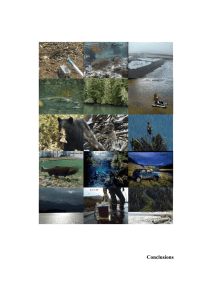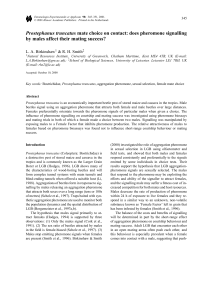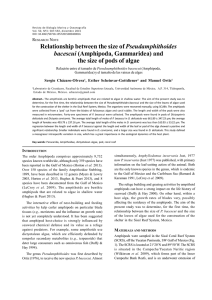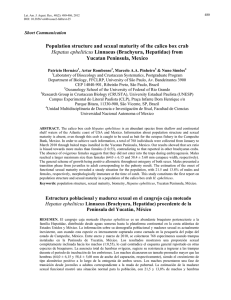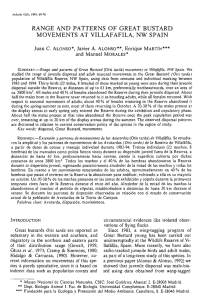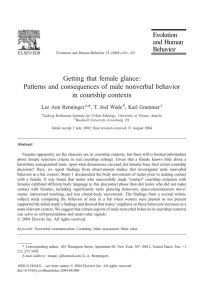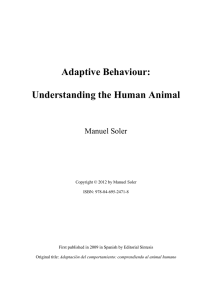article
Anuncio
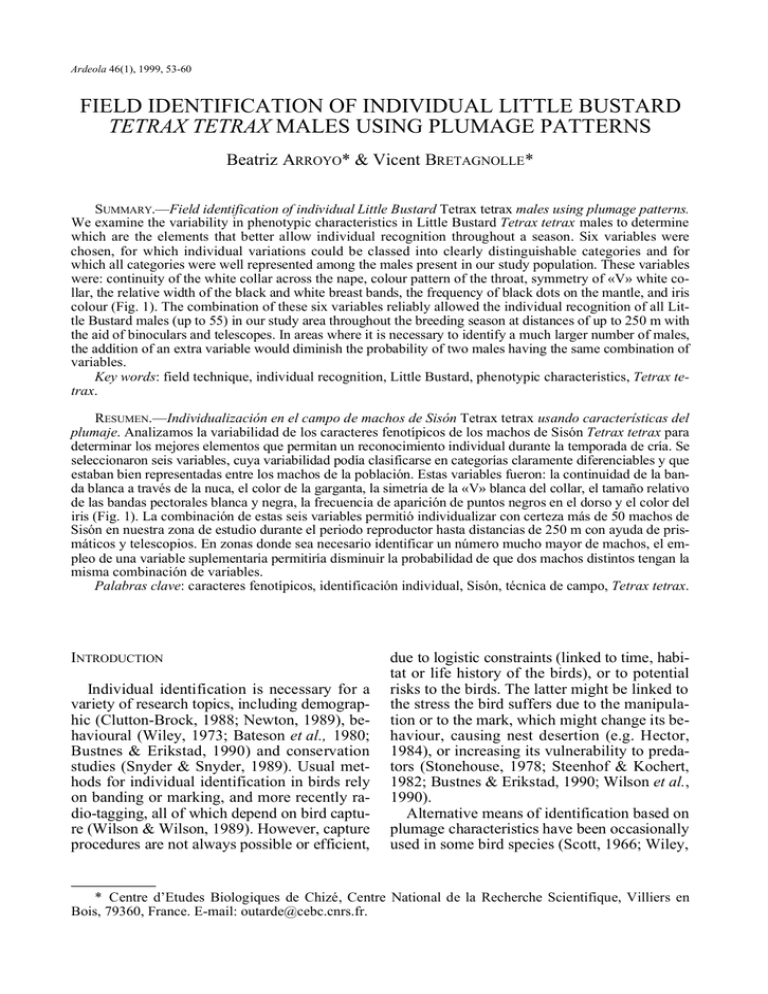
Ardeola 46(1), 1999, 53-60 FIELD IDENTIFICATION OF INDIVIDUAL LITTLE BUSTARD TETRAX TETRAX MALES USING PLUMAGE PATTERNS Beatriz ARROYO* & Vicent BRETAGNOLLE* SUMMARY.—Field identification of individual Little Bustard Tetrax tetrax males using plumage patterns. We examine the variability in phenotypic characteristics in Little Bustard Tetrax tetrax males to determine which are the elements that better allow individual recognition throughout a season. Six variables were chosen, for which individual variations could be classed into clearly distinguishable categories and for which all categories were well represented among the males present in our study population. These variables were: continuity of the white collar across the nape, colour pattern of the throat, symmetry of «V» white collar, the relative width of the black and white breast bands, the frequency of black dots on the mantle, and iris colour (Fig. 1). The combination of these six variables reliably allowed the individual recognition of all Little Bustard males (up to 55) in our study area throughout the breeding season at distances of up to 250 m with the aid of binoculars and telescopes. In areas where it is necessary to identify a much larger number of males, the addition of an extra variable would diminish the probability of two males having the same combination of variables. Key words: field technique, individual recognition, Little Bustard, phenotypic characteristics, Tetrax tetrax. RESUMEN.—Individualización en el campo de machos de Sisón Tetrax tetrax usando características del plumaje. Analizamos la variabilidad de los caracteres fenotípicos de los machos de Sisón Tetrax tetrax para determinar los mejores elementos que permitan un reconocimiento individual durante la temporada de cría. Se seleccionaron seis variables, cuya variabilidad podía clasificarse en categorías claramente diferenciables y que estaban bien representadas entre los machos de la población. Estas variables fueron: la continuidad de la banda blanca a través de la nuca, el color de la garganta, la simetría de la «V» blanca del collar, el tamaño relativo de las bandas pectorales blanca y negra, la frecuencia de aparición de puntos negros en el dorso y el color del iris (Fig. 1). La combinación de estas seis variables permitió individualizar con certeza más de 50 machos de Sisón en nuestra zona de estudio durante el periodo reproductor hasta distancias de 250 m con ayuda de prismáticos y telescopios. En zonas donde sea necesario identificar un número mucho mayor de machos, el empleo de una variable suplementaria permitiría disminuir la probabilidad de que dos machos distintos tengan la misma combinación de variables. Palabras clave: caracteres fenotípicos, identificación individual, Sisón, técnica de campo, Tetrax tetrax. INTRODUCTION Individual identification is necessary for a variety of research topics, including demographic (Clutton-Brock, 1988; Newton, 1989), behavioural (Wiley, 1973; Bateson et al., 1980; Bustnes & Erikstad, 1990) and conservation studies (Snyder & Snyder, 1989). Usual methods for individual identification in birds rely on banding or marking, and more recently radio-tagging, all of which depend on bird capture (Wilson & Wilson, 1989). However, capture procedures are not always possible or efficient, due to logistic constraints (linked to time, habitat or life history of the birds), or to potential risks to the birds. The latter might be linked to the stress the bird suffers due to the manipulation or to the mark, which might change its behaviour, causing nest desertion (e.g. Hector, 1984), or increasing its vulnerability to predators (Stonehouse, 1978; Steenhof & Kochert, 1982; Bustnes & Erikstad, 1990; Wilson et al., 1990). Alternative means of identification based on plumage characteristics have been occasionally used in some bird species (Scott, 1966; Wiley, * Centre d’Etudes Biologiques de Chizé, Centre National de la Recherche Scientifique, Villiers en Bois, 79360, France. E-mail: [email protected]. 54 ARROYO, B. & BRETAGNOLLE, V. 1973; Brown & Lewis, 1977; Bateson et al., 1980; Evans & Sladen, 1980; Stoddard & Beecher, 1983; Whitfield, 1986; Bretagnolle et al., 1994), and have in cases proved to be valid ways to identify individuals even among years (Bretagnolle et al., 1994; Thibault & Bretagnolle, unpubl. data). The Little Bustard (Tetrax tetrax) is a protected elusive steppic bird (del Hoyo et al., 1996). Numbers of this species are rapidly declining in most European countries (Tucker & Heath, 1994), and especially in France (Jolivet, 1996), which holds nevertheless the third most important population in Europe, after Spain and Portugal (Tucker & Heath, 1994). Due to its conservation status, trapping is problematic in most areas. In contrast, information on several topics that need individual identification is extremely necessary in order to make sure that conservation measures will be efficient. We examine here the variability in plumage and bare parts in males of this species, to determine which are the elements that better allow individual recognition throughout a season. METHODS The study area is located in western France, in the Département des Deux Sèvres, Région Poitou-Charente (46°11′N, 0°28′W), and covers ca. 340 km2. Land use is mainly agricultural, with a mixture of winter cereal crops (ca. 35% of the surface), other winter crops like rapeseed and peas (ca. 15%), spring-sown crops (sunflower and corn, ca. 25%), and pasture land and other permanent or semi-permanent crops devoted to livestock rearing (ca.15%). The Little Bustard population in the study area has been monitored since 1994 and is currently declining (V. Bretagnolle, unpubl. data). The study area was checked regularly (at least once a week) from April to July by a team of 3-8 people to detect displaying males. Males were located from the network of tracks that criss-crosses the study area, and were observed from inside the car through 10x binoculars and telescopes. In 1997, plumage features of observed males were drawn as detailed as possible on blank silhouettes of Little Bustard when observation conditions were appropriate (in terms of distance to the male, light and visi- bility). Average distance between observers and drawn birds was 104 ± 51 m (range 30 - 250). A total of 80 drawings from 33 males were made by a total of eight different observers. In these drawings, the following variables were described when possible: iris and beak colour; characteristics (width, continuity and irregularities) of the black and white breast bands, of the «V» white collar and of the white collar across the nape; plumage pattern of the throat, mantle, cap and ear coverts. From all these phenotypic variables, six were finally selected following two guidelines: (i) individual variations could be classed into a few, clearly distinguishable, categories and (ii) all categories were well represented among the males present in the population. These variables were the following (see Fig. 1): (1) iris colour, categorised as pale yellow, amber or dark orange; (2) Relative width of the black and white breast bands, categorised as: black band wider than white, both bands of equal width, or white band wider than black (Fig. 1a); (3) Symmetry of «V» white collar, categorised as symmetrical, asymmetrical on the right side, or asymmetrical on the left side (Fig. 1b); in our study area, none of the 26 males for which symmetry was noted were found with asymmetry on both sides; (4) throat pattern, categorised as pale, U shaped or dark (Fig. 1c); (5) continuity of the white collar across the nape, categorised as continuous, interrupted by a thin prolongation of the crown feathers, or discontinuous (crown feathers cover the band over more than half the nape, Fig. 1d); (6) frequency of black dots on the mantle, categorised as absent, present and small, or present and large (Fig. 1e). Not all variables could be noted each time, depending on observation conditions, so some drawings were incomplete. Thus the number of males in which each variable has been described varied (see Table 1). Drawings were subsequently compared and used to check for consistency of scoring the different variables among drawings, among observers and throughout the season. Males in this species are territorial, and maintain their territory throughout the breeding season (Schulz, 1985). Additionally, density of males in our study area is low, and males are rather distant from each other (mean ± S.D. = 950 ± 740 m). Thus drawings of males made at different dates but located in the same or a nearby INDIVIDUAL IDENTIFICATION OF LITTLE BUSTARD MALES 55 FIG. 1.—Plumage characteristics used to describe Little Bustard males. a) relative width of the white and black breast bands: (1) black band wider than white; (2) equal width; (3) white band larger than black; b) symmetry of the «V» white collar: (1) symmetric; (2) asymmetric on the left side; (3) asymmetric on the right side; c) throat pattern: (1) pale; (2) U-shaped; (3) dark; d) continuity of the white collar across the nape: (1) continuous; (2) interrupted by a thin trait; (3) clearly interrupted; e) frequency of black spots on the mantle: (1) absent; (2) small; (3) large and numerous. [Caracteres de plumaje usados en las descripciones de machos de Sisón Común. a) anchura relativa de las bandas pectorales blanca y negra: (1) la negra más ancha que la blanca; (2) anchura equivalente; (3) la blanca más ancha que la negra; (b) simetría del collar blanco en «V»: (1) simétrico; (2) asimétrico en la izquierda; (3) asimétrico en la derecha; c) patrón de la garganta: (1) pálida; (2) en forma de U; (3) oscura; d) continuidad de la banda blanca en la nuca: (1) continua; (2) ligeramente discontinua; (3) claramente discontinua; e) motas oscuras en el dorso: (1) ausentes; (2) pequeñas; (3) numerosas y grandes.] 56 ARROYO, B. & BRETAGNOLLE, V. TABLE 1 Occurrence of different phenotypic characteristics among male Little Bustards in a French population. n = number of males described; % = percentage of males having the character; P = probability of departure from a binomial distribution. [Frecuencia de aparición de diversos caracteres fenotípicos en los machos de Sisón Común en una población francesa. n = número de machos descritos; % = porcentaje de machos que presentaron el carácter; P = probabilidad de desviación de una distribución binomial.] Character n Relative width of the black and white breast bands [Anchura relativa de las bandas pectorales blanca y negra] Black wider than white [Negra más ancha que la blanca] Equal width [Anchura equivalente] White wider than black [Blanca más ancha que la negra] Throat pattern [Patrón de la garganta] Pale [Pálida] Dark [Oscura] Irregular (U-shaped) [Irregular, en forma de U] Dark spots on the mantle [Puntos oscuros en el dorso] Absent [Ausentes] Small [Pequeños] Numerous and large [Numerosos y grandes] Continuity of the white bar across the nape [Continuidad de la banda blanca a través de la nuca] Continuous [Continua] Interrupted by a thin trait [Ligeramente interrumpida] Clearly interrupted [Claramente discontinua] Iris color [Color del iris] Pale yellow [Amarillo pálido] Amber [Ambar] Dark / orange [Oscuro / naranja] Symmetry of V collar [Simetría de la «V» blanca del collar] Symmetric [Simétrica] Asymmetric on right side [Asimétrica en el lado derecho] Asymmetric on left side [Asimétrica en el lado izquierdo] field were tentatively considered as belonging to the same male. The validity of the latter assumption was checked comparing the similarity of each pair of drawings presumably belonging to the same male (i.e. drawn in the same field) to the similarity of drawings of random pairs of males (i.e. drawn at distant fields). Random pairs of males were sampled from the complete list of males using a statistical package (Minitab 10.2). Repeatability or consistency of male’s drawings was defined as the percentage of variables that were concordant among drawings of presumably identical males. Males in each site were drawn an average of 2.2 times (range 1-5) by an average of 1.9 different observers (range 1-4). % 30 P 0.2 20 53 27 27 0.025 41 52 7 31 0.7 35 29 36 33 0.8 36 24 39 24 0.7 42 33 25 26 0.4 50 38 12 RESULTS The three categories established for the six selected variables were randomly represented in our population of Little Bustard males, following a binomial distribution (Table 1) except for the throat pattern, which followed apparently a Poisson distribution (P = 0.08). The percentage of variables described that was concordant among drawings of males present in the same site at different dates was significantly higher than that of random pairs of males (Kolmogorov-Smirnov Test, D = 0.89, n = 36, P < 0.0001; Fig. 2). A single pair of drawings from the same field had a rather low value of 30% (Fig. 2), and presumably two dif- INDIVIDUAL IDENTIFICATION OF LITTLE BUSTARD MALES 57 FIG. 2.—Percentage of variables described that were concordant among pairs of drawings of males present in the same field at different dates (open bars) and random pairs of male drawings (closed bars). [Proporción de variables descritas que concordaban entre pares de dibujos de machos presentes en la misma parcela en fechas distintas (barras vacías) y parejas aleatorias de dibujos (barras llenas).] ferent birds were involved. In any case, it could be safely assumed that drawings of males differing in more than 30% of the variables pertained to different males. Average repeatability of drawings of the same males was 83.4% when this latter pair of drawings was considered to be from the same male, and 86.4% when such drawings were not considered (n = 18 males with at least three variables described at least twice). Variations in the concordance between 80% and 100% were thus probably due to errors in recording different variables. Repeatability of different variables was defined as the percentage of drawings pertaining to the same male where a given variable was described and was concordant. Repeatability of the six categorical variables retained was relatively high (Table 2). The lowest repeatability was for iris colour, which was not surprising, as light conditions might change the quality of the observation. In fact, iris colour was one of the variables that was less often reported. As the six characters described had each three possible categories, the combination of these six variables leads to a maximum theoretical number of different combinations of 36, i.e. 729 individuals. In our study, for the individuals in which all these characters could be assessed (n = 22), none showed the same combination. In fact, the probability of the 22 individuals having all a different combination was high, i.e. 0.71 (729 × 728 × 727 × ... × 708 × 707/ 72922) under the assumption of equiprobability of each combination. DISCUSSION As variation in the phenotypic variables chosen could be classed into clearly distinguishable categories (Fig. 1), this technique can be rapidly and easily applied on the field to all sightings of males by preparing a sheet with the different patterns where the characteristics of every individual may be easily ticked. In our study, repeatability of variable scores of individual males was over 80%. This figure is an absolute minimum, and it can be expected to improve in the future, given that this was the first year that the technique was applied and that many drawings were incomplete. Thus, drawings differing on more than 20% of the variables are likely to belong to different males. This technique therefore easily and accurately addresses the problem of whether different sightings refer to the same male or not. Individual ringing of males (currently under way) will give further strength to this conclusion, and will help to determine more accurately the threshold level of variable differences. 58 ARROYO, B. & BRETAGNOLLE, V. TABLE 2 Concordance among drawings of different characters in males for which a given character was described at least twice. Sample size (number of drawings) is shown in brackets. [Concordancia entre dibujos de cada uno de los caracteres fenotípicos descritos en machos para los que un determinado carácter se ha descrito al menos dos veces. El tamaño muestral (número de dibujos) se indica entre paréntesis.] Repeatability [Concordancia] Ratio of black/white bars [Anchura relativa de bandas blanca y negra] Throat pattern [Patrón de la garganta] Symmetry of the V collar [Simetría del collar en V] Spots on the mantle [Puntos oscuros en el dorso] Bar across the nape [Banda de la nuca] Iris color [Color del iris] The potential implications of our findings are very wide in this species. Little Bustard males are territorial, with territories being usually distributed in dense groups (Cramp & Simmons, 1980), and their mating system is a dispersed lek (Schulz, 1985). The possibility of identifying individual males throughout the season may thus allow to get data on aspects such as territory size, movements of males between territories, territory overlap or switching, all of which are, to a large extent, currently lacking for the species. Similarly, all analyses up to present of territory quality and habitat selection have been based on characteristics of fixed areas around single points (Martínez, 1994; Salamolard et al., 1996; Salamolard & Moreau, 1999), but this technique of identification may allow to detect variations of habitat use at the individual level. Individual identification of males also improves the accuracy of population monitoring or phenology of arrival and departure of males. This is particularly relevant for areas where the population is rapidly declining, as happens in most of the areas in western France (Jolivet, 1996) and apparently in some areas of Spain (Díaz et al., 1993; Etcheverría & Astraín, unpubl. report). The application of this technique in our population in 1998 proved very useful to differentiate a total of 55 males (F. Jiguet & V. Bretagnolle, unpubl. data). The maximum number of possible combinations of the six chosen variables is 729, so we believe that the technique 82.3 % (34) 90.4 % (42) 90.0 % (30) 90.6 % (32) 92.3 % (52) 78.9 % (19) could be also applied in other localities regardless of the Little Bustard density when individual identification of Little Bustard males is needed. We propose that, in areas where the number of individually studied males is much larger than in our study, or if some characters are not uniformly distributed, the description should include one or two supplementary variables (such as colour of the head or the presence or absence of particular markings), in order to decrease the probability of two males having the same pattern of variables. We also suggest that similar techniques could be applied to allow individual identification in other species of bustards, all of which have males with very distinct plumage characters in the breeding season (del Hoyo et al., 1996). Use of individual plumage variation for identification of other bird species has been shown to be reliable in many field studies (Ruddy Turnstone Arenaria interpres, Whitfield, 1986; Bewick’s Swan Cygnus columbianus, Scott, 1966; Bateson et al., 1980; Sage Grouse Centrocercus urophasianus, Wiley, 1973; Gibson et al., 1991; Osprey Pandion haeliaetus, Bretagnolle et al., 1994). Results from this study suggest, similarly, that a combination of simple characters reliably allowed the individual recognition of all Little Bustard males in our study area throughout the breeding season. No data exist so far to confirm whether the individual characteristics used here vary among years, and thus whether long- INDIVIDUAL IDENTIFICATION OF LITTLE BUSTARD MALES term individual recognition is possible. However, plumage patterns change only slightly from year to year in Ospreys (Bretagnolle et al., 1994), which allowed individual identification in the field for that species. We therefore highly encourage other people studying Little Bustards to apply this technique, to assess whether that is also the case in the Little Bustard. If that proved correct, this technique would open the possibility of easily and harmlessly assessing vital parameters such as survival, at least for males. ACKNOWLEDGMENTS.- Many people have helped in collecting data, particularly drawings: R. Bernard, T. de Cornullier, C. Duriez, D. Pinaud, M.-H. Froger, F. Jiguet, L. Kuller and F. Mougeot. The latter also drew the figure. We are very grateful to all of them. This study is part of a Conservation Program on the Little Bustard in France, co-ordinated by LPO and funded by Life-CEE, French Ministère de l’Environnement, Région Poitou-Charente and Département des Deux-Sèvres. Carmen Martínez and an anonymous referee commented on the MS. BIBLIOGRAPHY BATESON, P., LOTWICK, W. & SCOTT, D. K. 1980. Similarities between the faces of parents and offspring in Bewick’s swan and the differences between mates. Journal of Zoology, 191: 61-74. BRETAGNOLLE, V., THIBAULT, J. C. & DOMINICI, J. M. 1994. Head patterns allow field identification of individual Ospreys. Journal of Wildlife Management, 58: 175-178. BROWN, J. & L EWIS, V. 1977. A laboratory study of individual recognition using Bewick’s swan bill patterns. Wildfowl, 28: 159-162. BUSTNES, J. O. & ERIKSTAD, K. E. 1990. Effects of patagial tags on laying date and egg size in common eiders. Journal of Wildlife Management, 54: 216-218. CLUTTON -BROCK, T. H. (ed.). 1988. Reproductive Success. University of Chicago Press, Chicago. CRAMP, S. & SIMMONS, K. E. L. (Eds.) 1980. The Birds of the Western Paleartic, Vol. 2. Oxford University Press. Oxford. DEL HOYO , J., ELLIOT, A. & SARGATAL, J. 1996. Handbook of the Birds of the World, Vol 3. Lynx Edicions. Barcelona. DÍAZ, M., NAVESO , M. A. & REBOLLO, E. 1993. Respuestas de las comunidades nidificantes de aves a la intensificación agrícola en cultivos cerealistas de la Meseta Norte (Valladolid-Palencia, España). Aegypius, 11: 1-6. 59 EVANS, M. E., & SLADEN, W. J. L. 1980. A comparative analysis of the bill markings of whistling and Bewick’s swans and out-of-range occurrences of the two taxa. Auk, 97: 697-703. GIBSON, R. M., BRADBURY, J. W. & VEHRENCAMP, S. 1991. Mate choice in lekking sage grouse revisited: the roles of vocal display, female site fidelity, and copying. Behavioural Ecology, 2: 165180. HECTOR, J. A. L. 1984. Techniques for the serial collection of blood samples and inspection of gonads in free living albatrosses. British Antarctic Survey Bulletin, 63: 127-133. JOLIVET, C. 1996. L’Outarde canepetière Tetrax tetrax en déclin en France. Situation en 1995. Ornithos, 3: 73-77. MARTÍNEZ, C. 1994. Habitat selection by the Little Bustard Tetrax tetrax in cultivated areas of central Spain. Biological Conservation, 67: 125-128 NEWTON, I. (ed.). 1989. Lifetime reproduction in birds. Academic Press. San Diego. SALAMOLARD, M. & MOREAU, C. 1999. Habitat selection by Little Bustards Tetrax tetrax in an cultivated area of France. Bird Study, 40: 25-33. SALAMOLARD , M., BRETAGNOLLE, V. & BOUTIN, J. M. 1996. Habitat use by Montagu’s Harrier, Little Bustard and Stone Curlew in western France: crop types and spatial heterogeneity. In, J. Fernández Gutiérrez & J. Sanz Zuasti (Eds.): Conservation of stepparic birds and their habitats, pp. 209-220. Junta de Castilla y Leon. Valladolid. SCHULZ, H. 1985. Grundlagenforschung zur Biologie der Zwergtrappe Tetrax tetrax. PhD thesis. Staatlichen Naturhistorischen Muse um. Braunschweig. SCOTT, P. 1966. The Bewick’s swans at Slimbridge. Wildfowl Trust Annual Report, 17: 20-26. SNYDER, N. F. R. & SNYDER, H. A. 1989. Biology and conservation of the California condor. In, D. M. Power (Ed.): Current ornithology, vol. 6, pp. 175-268. Plenum Press. New York. STEENHOF, K. & KOCHERT, M. N. 1982. An evaluation of methods used to estimate raptor nesting success. Journal of Wildlife Management, 46: 885893. STODDARD, P. K. & BEECHER, M. D. 1983. Parental recognition of offspring in the cliff swallow. Auk, 100: 795-799. STONEHOUSE , B. (ed.). 1978. Animal marking: recognition marking of animals in research. University Park Press. Baltimore. TUCKER, G. M. & HEATH, M. F. 1994. Birds in Europe: their conservation status. Birdlife International (Birdlife Conservation Series no 3). Cambridge, UK. WHITFIELD, D. P. 1986. Plumage variability and territoriality in breeding turnstones: status signalling or individual recognition? Animal Behaviour, 34: 1471-1482. 60 ARROYO, B. & BRETAGNOLLE, V. WILEY, R. H. 1973. The strut display of male sage grouse: a «fixed» action pattern. Behaviour, 47: 129-152. WILSON, R. P. & WILSON, M.-P. T. J. 1989. A minimal-stress bird capture technique. Journal of Wildlife Management, 53: 77-80. WILSON, R. P., WILSON, M.-P. T. J., S PAIRANI, H. J., CORIA, N. R., CULIK, B. M. & ADELUNG, D. 1990. Packages for attachment to seabirds: what color do Adélie penguins dislike least? Journal of Wildlife Management, 54: 447-451. [Recibido: 23-10-98] [Aceptado: 13-1-99]

